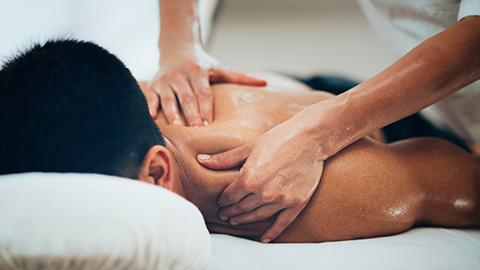
A massage therapist notices some changes in the texture of their client’s tissues. When they ask about it, the client replies, “Oh! Those are my pellets!”
It turns out he has had testosterone pellets inserted into the tissues of his hip. What kinds of massage therapy accommodations are necessary in this situation? Tune in to find out!
Pellet Implant Procedure (YouTube video)
Resources:
BioTE FAQ (no date) FMC Clinics. Available at: www.fmcclinics.com/biote-faq
How effective are testosterone pellets: Side effects and benefits (2018). Available at: www.medicalnewstoday.com/articles/322642
Lv, W. et al. (2016) ‘Low Testosterone Level and Risk of Alzheimer’s Disease in the Elderly Men: a Systematic Review and Meta-Analysis’, Molecular Neurobiology, 53(4), pp. 2679–2684. doi:10.1007/s12035-015-9315-y.
Pelleted Hormone Therapy—More Risks, Questionable Benefits, Warn Experts (no date) EndocrineWeb. www.endocrineweb.com/news/other-endocrine-disorders/62510-pelleted-hormone-therapy-more-risks-questionable-benefits-warn-
‘Post-Pellet Insertion Instructions | Peoria IL | Couri Center’ (2020), 30 January. Available at: www.couricenter.com/post-procedural-care-instructions/post-pellet-insertion-instructions/
Testopel (Testosterone Pellets): Uses, Dosage, Side Effects, Interactions, Warning (no date) RxList. Available at: www.rxlist.com/testopel-drug.htm
Testosterone Pellets. (2021) Healthline. Available at: https://www.healthline.com/health/testosterone-pellets
Testosterone Treatment, A Risky Bet? | Cognitive Vitality | Alzheimer’s Drug Discovery Foundation (no date). Available at: www.alzdiscovery.org/cognitive-vitality/blog/testosterone-treatment-a-risky-bet
Wahjoepramono, E. J. et al. (2016) ‘The Effects of Testosterone Supplementation on Cognitive Functioning in Older Men’, CNS & Neurological Disorders Drug Targets, 15(3), pp. 337–343. doi:10.2174/1871527315666151110125704.


This podcast sponsored by:
About Anatomy Trains:
Anatomy Trains is a global leader in online anatomy education and also provides in-classroom certification programs forstructuralintegration in the US, Canada, Australia, Europe, Japan, and China, as well as fresh-tissue cadaverdissectionlabs and weekend courses. The work of Anatomy Trains originated with founder Tom Myers, who mapped the human body into 13 myofascial meridians in his original book, currently in itsfourthedition and translated into 12 languages. The principles of Anatomy Trains are used by osteopaths,physicaltherapists,bodyworkers,massagetherapists,personaltrainers,yoga,Pilates,Gyrotonics,and other body-minded manual therapists and movement professionals. Anatomy Trains inspires these practitioners to work with holistic anatomy in treating system-wide patterns to provide improved client outcomes in terms of structure and function.
Website:anatomytrains.com
Email:info@anatomytrains.com
Facebook:facebook.com/AnatomyTrains
Instagram: instagram.com/anatomytrainsofficial
0:00:00.0 Speaker 1: Ruth Werner's best-selling book, A Massage Therapist's Guide to Pathology, is a highly regarded comprehensive resource that sets the standard for pathology education. Written for massage therapy students and practitioners, this ground-breaking resource serves up a comprehensive review of the pathophysiology, signs, symptoms and treatment of more than 500 diseases and disorders. Learn more at Booksofdiscovery.com.
0:00:32.7 Speaker 2: Anatomy Trains, is delighted to announce a brand new dissection live stream specialty class on September 18th. Lumbopelvic stability, a one-day layered dissection with Anatomy Trains author, Tom Myers, and master dissector, Todd Garcia. The early bird price of $150 is held until September 10th. After September 10th, the price is $250. Come see the body's actual core for yourself. This course will be provided over Zoom webinar with multiple camera views, live chat and Q&A. Visit Anatomytrains.com to sign up.
[music]
0:01:15.5 Ruth Werner: Hi, and welcome to I Have A Client Who: Pathology Conversations with Ruth Werner, the podcast where I will discuss your real life stories about clients with conditions that are perplexing or confusing. I'm Ruth Werner, author of A Massage Therapist's Guide to Pathology, and I have spent decades studying, writing about and teaching about where massage therapy intersects with diseases and conditions that might limit our client's health. We almost always have something good to offer, even with our most challenged clients, but we need to figure out a way to do that safely, effectively and within our scope of practice. And sometimes, as we have all learned, that is harder than it looks. One of the wonderful things that doing this podcast has taught me is that while I know a lot about massage therapy and pathology, I always get to learn new things. I recently got a question about a situation I've never heard of before, so I'm happy to share my learning process with you here.
0:02:21.0 RW: And it came from a massage therapist who shared this, "A long-time male client showed up today early to mid-40s, cross-fitter. When I worked on his glutes, this happened." Me, "Hey, any sensations you're feeling right here because I'm feeling a tissue change?" Client, "Oh yeah, those are my pellets." Me, "Pellets for what? Let's stop for a sec, so you can fill me in on this." Well, it turns out that the client had had TESTOPEL Pellets implanted. His father has Alzheimer's or some other kind of dementia, and he uses this to ward this off for himself. He was noticing some brain changes and his testosterone levels were extremely low. Here are my questions. Number one, what can and can't you massage when they have the pellets? This client has them in his hip at the medial edges of the gluteus medius. I'm thinking no massage on the injection site and on top of the pellets. Is there a width from the site you'd stay away from? The client stated they're inserted into the muscle tissue and fibers for slow release. Number two, this is also a cupping client. I usually cup the edges of the hip joint.
0:03:27.8 RW: Thoughts? No cupping in that area at all? Only one article online says, no massage in the area for six months. If that's the case, definitely no cupping either. Number three. In rare cases, people reported DVTs. Shall I listen for those kinds of symptoms at each session? And number four, does anyone have any clients who have these? If so, what things did you watch for during the massage? What questions should I be asking to keep this client safe? They start on a low dose and slowly increase based on blood work. Is there anything I need to watch for during these times? Ruth Werner, do you have a podcast on this? Well, I didn't, but I do now. Okay. Testosterone pellets. I confess this is completely new to me, and I went down some really odd rabbit holes to figure out some ideas about massage therapy. Who knew there's a condition called, and I am not making this up, Vanishing Testicle Syndrome.
0:04:29.7 RW: It's associated with cryptorchidism, a situation where an infant's testicles don't fully descend. But that's not our client for today. Today we will look at testosterone pellet use in adults, like the client in this story. A number of people responded to this contributor's query, so clearly, massage therapists are seeing clients with testosterone tablets, and I'm very happy to add my two cents. We probably all know that testosterone is a hormone secreted created mainly by the testes, and it has to do with secondary sexual characteristics. Women also secrete testosterone, by the way.
0:05:07.7 RW: We make it in our ovaries and adrenal glands, and sometimes in fat cells. Like any hormone, people need testosterone in just the right amounts. Too little and men may feel sluggish with a decreased libido, increased body fat, irritability and depression. And as this client noted, low testosterone levels are associated with Alzheimer's disease and maybe some other forms of dementia. I'll get back to that in a minute. If a male has too much testosterone, well, this opens the door for a whole different set of problems like heart disease and the possibility of major adverse cardiac events. I learned that as a new acronym. MACE, Major Adverse Cardiac Events. Also a condition called Polycythemia, where there are too many red blood cells, and an increased risk for certain types of cancer And some other minor but really irritating things like acne, and large breasts, breast tenderness, and maybe not so minor for some patients, shrinking testes.
0:06:08.9 RW: The condition of hypogonadism, that is testosterone levels that are consistently lower than the norm, they affect somewhere between 20% to 40% of older men. Side note, the term older men was not defined in this resource, and I'm not sure that our mid-40s cross-fitting client would fit here. So if his testosterone levels are lower than normal, that definitely deserves a closer look from his healthcare team, and it's great that he's taking care of this. The typical treatment for hypogonadism is to supplement testosterone. This turns out to be a little tricky. People can use an oral supplement, but sometimes that doesn't work well. Sometimes it is supplemented via a cream, or gel, or patch or injections, or as we see in this case, implanted pellets that release testosterone slowly over a period of three to four months.
0:07:05.6 RW: Using sub-dermal pellets is a relatively new option for testosterone supplementation. It has some advantages. The creams and gels can cause skin irritation and they can affect other people who touch the user, like children in their household, or sexual partners, or, and I have had letters on this, massage therapists who may work in an area where a cream has been applied and therefore be accidentally dosed with testosterone. Who saw that as an occupational hazard? Testosterone can be directly injected, but this tends to create a lot of side effects with a sudden introduction of a lot of hormone that then wears off really quickly. This can cause some physical and emotional roller coaster effects that are extremely unpleasant.
0:07:50.8 RW: By contrast, testosterone pellets, and the trade name here is TESTOPEL. These pellets are inserted into the deep fascia and muscle tissue, usually somewhere along the posterior aspect of the iliac crest, which is consistent with what our contributor reports. The procedure can be done in a doctor's office. I even found a YouTube of it being done, and I included a link in the show notes. The pellets are meant to stay in place and the patient doesn't have to administer frequent doses or risk exposing anyone else in his life to this treatment. To do this, the skin is cleaned and numbed with lidocaine, and then an instrument called a trocar inserts about 10 tiny pellets, these are roughly 3 millimeters across and 10 millimeters long. About like a small grain of rice, into the flesh. The pellets hold testosterone in a crystalline form that is released slowly over the course of three to four months, sometimes it can last as much as six months, but that release mechanism is a point of confusion for me.
0:08:54.0 RW: The only resource I could find that addresses the question of what prompts the hormone to be released is said that it was in response to cardiac activity and it was not regulated by time alone. I'm not sure how that works. And another resource written by a doctor who no longer uses pellets, suggests that this release mechanism might not work for some patients whose levels drop before the four-month target and then they have to keep supplementing testosterone in another way. And the pallets come with their own sets of risks. As our contributor, who did a bang-up job of gathering background information on this, by the way. As that person notes, there's a small but not zero risk of DVT with these. They can cause irritation and scarring where they're inserted. And in some cases, they can get infected and the pellets can kind of work their way out of the body, again, this is called extrusion. And once they're in, they can't really be adjusted. For this reason, men who are candidates for testosterone pellets are often advised to use other forms of testosterone supplements first, so the dose that establishes his best benefits with the least side effects can be found. This then guides the decision about how many pellets to use with each application. As the pellets release their contents, they dissolve completely, they do not leave a little capsule or any other kind of residue behind.
0:10:20.7 RW: So let's go back and think about our client. Here's a man in his 40s, he's been seeing this massage therapist for a while, he's using TESTOPEL for low testosterone, and also as a preventive for dementia which he sees as a risk because of his father. That's a real association. Low testosterone is definitely associated with dementia and Alzheimer's disease. However, I poked around a little bit about this, and so far, the data on whether supplementing testosterone helps to prevent dementia. That data is not great. I hope it works out for this guy, of course. Then I started to look for any guidance about massage therapy and any kind of hormone pellets. Luckily, I found a document for after care when a person has had this procedure done and they recommend a few relevant things. First, they suggest no vigorous exercise for three days, but even more helpfully, they say, and I quote, "Avoid massage directly at the pellet site for six months." And the word 'directly' is in bold. Well, thank you Corey Center, for your post-pellet insertion instructions. And then I found that same language at several other sites, probably all quoting the same manufacturer's recommendations. And this guidance is super useful.
0:11:42.7 RW: I'm so glad it's here. And it's probably because friction over these rice grains would probably be really uncomfortable, and we don't wanna run the risk of loosening them so they can work their way out of the body. But it makes me wonder about how widely we should avoid the insertion site, and that of course is one of the questions that our contributor has. And this is why I was curious about the release mechanism. I wonder if direct pressure would cause the pellets to release their contents more quickly. In the interest of safety and conservatism, I recommend to avoid that area for a few inches, maybe three to five inches in every direction. That might be overly cautious. This would be a great subject to consult with the client's doctor about, wouldn't it? The other things this contributor brings up are good topics, too.
0:12:34.5 RW: Always watching for DVT signs. And I agree, cupping is not an option in this situation. Other than these cautions, I think we're probably on safe ground. As with any medication, it's good to get a sense of this person's side effects, but he's also under medical supervision, which means if anything unexpected happens, he can let his healthcare team know and they'll know what the situation is. So that was a fun exploration of an entirely new topic, testosterone pellets. Thanks for letting me explore with you and be sure to send me your 'I have a client who' stories for future adventures. Hey everybody, thanks for listening to I Have A Client Who: Pathology Conversations with Ruth Werner. Remember, you can send me your 'I have a client who' stories to ihaveaclientwho@abmp.com. That's, I have a client who, all one word, all lowercase, @ A-B-M-P.com. I can't wait to see what you send me, and I'll see you next time.